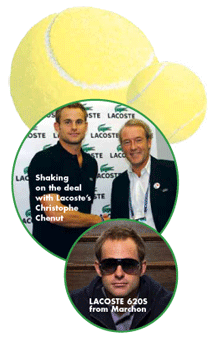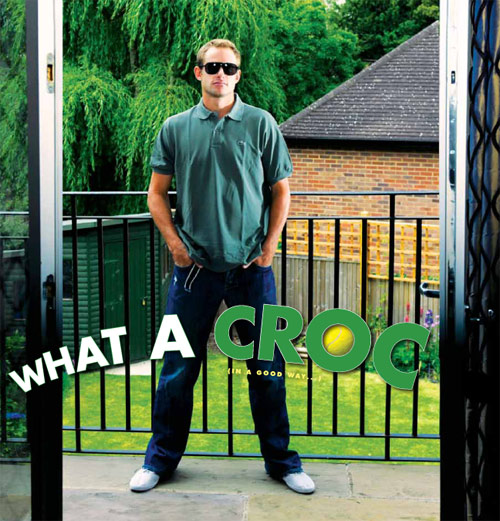
By Jackie Micucci
“Joe’s Shrimp Shack,” announces the voice on the other end of the phone. I pause and start to laugh as a whole monologue on fishing, peeling and grilling crustaceans unfolds. This is the Andy Roddick I have come to know via TV interviews, Twitter postings and many, many hours of watching tennis. An elite tennis player with a killer serve, Roddick is known equally for his on court skills and off court humor.
That humor is evident in his witticisms, especially on Twitter. While many celebrities and star athletes tend to tweet messages that self-promote (or many times bore), Roddick aims for entertainment. By way of example:
“how is lindsay lohan ever gonna find a good woman when she is in jail? wait... this might just work out”
“hankies are gross... you sneeze and snot into them, put them in a pocket, pull it out a couple hours later and put it all around your face”
“met the queen of england today... she said she loved me in the american pie movies”
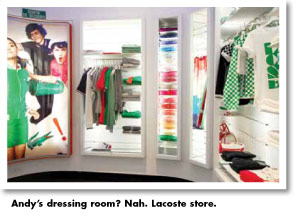 But when it comes to tennis, Roddick is all business. He has a serve that is explosive and, at times, completely un-returnable. It has been clocked at 150 mph. The power is generated from his legs, saving his shoulder from injury. The follow through when he smashes the ball across the net is like a sonic boom. In fact, when I think of Roddick, I picture that follow through and the force that makes his shirt flap against his body.
But when it comes to tennis, Roddick is all business. He has a serve that is explosive and, at times, completely un-returnable. It has been clocked at 150 mph. The power is generated from his legs, saving his shoulder from injury. The follow through when he smashes the ball across the net is like a sonic boom. In fact, when I think of Roddick, I picture that follow through and the force that makes his shirt flap against his body.
The shirt has also become an intrinsic part of the Roddick image: A traditional, pique polo by Lacoste. Most of the time it is paired with a matching baseball cap—usually drenched with sweat by the match’s end—adorned with Lacoste’s famous crocodile logo.
That’s what we’re here to talk about today. Roddick’s role as a Lacoste brand ambassador, a role he’s had since 2005. “It is a tennis brand that has also crossed over into pop culture,” explains Roddick, in London as we speak. (He’s here for the grass court season, which culminates with Wimbledon.) “It seemed like a good fit for me. I wore their clothing from the start so I was really excited about the possibility of being associated with them. The best thing about the brand is I don’t have to shop. It’s great because it’s a fashion brand that works both on and off the court.”
It makes sense that one of the world’s top men’s tennis player (he’s currently ranked number nine) is associated with a brand born and bred on the courts. In 1933, French tennis player René Lacoste revolutionized men’s on court fashion by replacing the classic woven, long-sleeved starched shirts with the Lacoste short sleeved jersey “petit pique” polo. It was adorned with a crocodile, a nickname Lacoste was given by the American press.
The Lacoste brand now encompasses a full line of men’s, women’s and children’s clothing, footwear, leather goods, fragrances, home goods, watches and, of course, eyewear. The brand has had a sunglass and ophthalmic frame collection since 1981, but there has been a changeover as they say in tennis. Marchon is now Lacoste’s new (and powerful) doubles partner.
While sunwear is worn by professional athletes in many different sports, tennis is not one of them. As someone who plays the game (albeit on a level that would be deemed somewhat amateur) I had my sneaking suspicions as to why shades aren’t a good fit for tennis. Roddick confirmed them. “Sweat,” he says. “You are constantly sweating and constantly moving.”
But Roddick does like sporting sunglasses when he’s not playing. “I wear them a lot off the court,” the 27-year-old tennis player says. “But I’m not a huge fan of the styles that cover 86 percent of your face. Lacoste has a line that’s pretty cool. I wear them casually. I can dress them up or down. I like that.”
Roddick is admittedly a “pretty casual” guy when it comes to his personal style, even if he is married to a model; Brooklyn Decker of Sports Illustrated Swimsuit Issue fame. (He’s no slouch himself, ranked number one you might say, having been voted as the Sexiest Athlete by People magazine.) “Normally after a tournament we go out to dinner and get food,” he notes. “But it’s usually not somewhere fancy.”
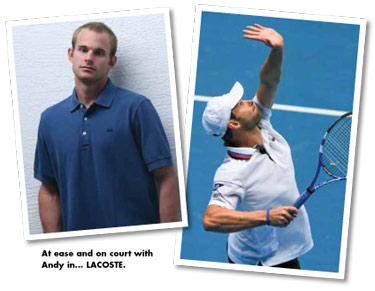 However, he is not casual when it comes to his tennis game. Roddick has worked hard to become a more well-rounded player since he burst onto the scene in 2001. In 2003, he won the U.S. Open, one of tennis’ four grand slam tournaments, with mainly that powerful serve as a weapon. Now he has more tools in his arsenal. “I’ve evolved by necessity,” he says. “When I came on, it was a lot more about shot making. Now it’s more about fitness. Everyone has become better. Your peers push you. One thing I’ve done well is I haven’t been too proud to make adjustments. It’s about adjusting and realizing where the game is.”
However, he is not casual when it comes to his tennis game. Roddick has worked hard to become a more well-rounded player since he burst onto the scene in 2001. In 2003, he won the U.S. Open, one of tennis’ four grand slam tournaments, with mainly that powerful serve as a weapon. Now he has more tools in his arsenal. “I’ve evolved by necessity,” he says. “When I came on, it was a lot more about shot making. Now it’s more about fitness. Everyone has become better. Your peers push you. One thing I’ve done well is I haven’t been too proud to make adjustments. It’s about adjusting and realizing where the game is.”
Roddick played an epic match against then-world-number-one Roger Federer last year for the title at Wimbledon. It was the longest Wimbledon final of all time, plus the longest final played in any of the four majors. Sadly, Roddick was on the losing end. He is genial when I tell him that it was one of the best matches I have ever watched, thanking me graciously. Like any top athlete worth his salt, he has moved on and is focused on the future.
Part of evolving is also learning how to pace yourself. The tennis season is a long one and it can burn players out if they are not careful. “I’ve learned to space out my schedule a little more,” says Roddick. “Ten/11 years ago I would play a lot more matches. Good scheduling is necessary. It is a matter of picking and choosing. I can’t play 25/26 events like I used to. There are so many events you could play every week. When I was younger I could handle it.”
Andy Roddick grew up in an athletic family. His brother John was an All-American tennis player at the University of Georgia who now operates a tennis academy in San Antonio, Texas. Older brother Lawrence was an accomplished spring board diver and member of the U.S. Senior National Team. They are all big University of Nebraska football fans and Roddick tweets about the trials and tribulations of the team during the season.
Roddick also played varsity basketball in high school. But, it was tennis where he truly excelled. He finished as the number-one junior in the U.S. 1999-2000 and the number-one junior in the world in 2000. He won six world junior singles and seven double titles, as well as the U.S. Open and Australian Open junior singles titles in 2000. He got his informal tennis education watching some of the greatest U.S. tennis players of our time.
“I was spoiled,” he says. “When I was growing up I came up on the tail end of the golden generation of Jimmy Connors and John McEnroe. It was the end of those careers and the beginning of the careers of Jim Courier, Pete Sampras, Andre Agassi and Michael Chang. I had a lot of guys I could look to. It was awesome for me to establish relationships with all those guys—Andre and Johnny Mac. I worked with Jimmy for a couple of years [Connors was his coach]. And now I’ve been able to spend time with each one. The thing is that it never gets old for me. Whenever we do events with the legends of the game I just try to stop and listen to what they’re saying.”
As for what the future holds for Roddick beyond tennis that may just involve, well, tennis but in a different venue: “I’ve made time for a lot of things I’ve wanted to do,” he says. “I’d like to be a commentator but I wouldn’t want to travel that much, that being said now I’ll probably end up doing that. Being Davis Cup captain some day, I’d like to do that.” The Davis Cup is the premier international team event for men’s tennis and consists of teams of players from different countries competing in a knock-out format.
It would be a good fit for Roddick. He has played 22 Davis Cup matches, including the 2007 final win over Russia, and is 31-11 in singles. He has been the leading singles player for the United States for most of his Davis Cup career.
He also plans to compete in mixed doubles tennis at the 2012 Olympics in London. He’ll be pairing up with good friend and the world number-one ranked woman, Serena Williams. “We’re planning on playing together,” Roddick says. “It’s been awesome. We’ve been friends since we were kids and came onto the tennis scene together. Once they announced the event, Serena was on the phone 26 seconds later begging me to play,” he jokes. “She’s got a bunch of gold medals so maybe she’ll help me get one.”
That’s Andy Roddick in a, dare we say, eyeglass case… nah, nutshell. A man who can adeptly lob shots both on and off the court.
Lacoste's Crocodile Years
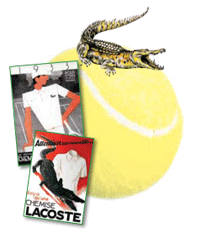 In 1933, industrial production of the first Lacoste shirts, in particular the white petit pique" cotton polo shirt code named "1212." A crocodile logo is placed on the shirt representing tennis champion René Lacoste's nickname. It is the first time a brand logo appears outside an article of clothing.
In 1933, industrial production of the first Lacoste shirts, in particular the white petit pique" cotton polo shirt code named "1212." A crocodile logo is placed on the shirt representing tennis champion René Lacoste's nickname. It is the first time a brand logo appears outside an article of clothing.
From 1940 to 1946 manufacturing is halted because of World War II.
In 1951, Lacoste gets colorful as a color range is added to the classic white polo shirt.
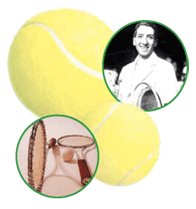 René Lacoste invents the first steel racket in 1963 leading the way for today's models. It is distributed in the U.S. by Wilson and is used by tennis champs Jimmy Connors and Billie Jean King.
René Lacoste invents the first steel racket in 1963 leading the way for today's models. It is distributed in the U.S. by Wilson and is used by tennis champs Jimmy Connors and Billie Jean King.
An apparel manufacturing agreement is signed with the United States in 1966.
René Lacoste invents and patents the "damper" used on Lacoste steel rackets in 1974. It is located on the end of the shaft and absorbs vibrations while improving accuracy.
In 1985, the company launches a new line of tennis shoes manufactured in France, followed by deck shoes in 1986 and walking shoes in 1988.
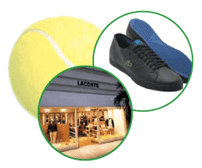 The Equijet racket is launched in 1990. Its unique shape combines the benefits of large-head and small-head rackets. Three years later, Guy Forget uses the racket to win the Davis Cup.
The Equijet racket is launched in 1990. Its unique shape combines the benefits of large-head and small-head rackets. Three years later, Guy Forget uses the racket to win the Davis Cup.
To mark its 60th anniversary, in 1993 Lacoste organizes a worldwide campaign in support of the fight against multiple sclerosis. The company raises more than $1 million.
In 1995, the first American boutiques are opened in Palm Beach and Bal Harbour, Fla.
Lacoste launches its Internet site in 1996. In December, a boutique opens on New York's Madison Avenue.
In 1999, the worldwide apparel license for the brand is granted to manufacturer Devanlay through 2012. That license is later extended until 2025. The agreement covers creation, manufacturing, distribution, merchandising and product advertising.
A worldwide licensing agreement for bags, luggage and small leather goods is signed with Samsonite in 2000. An agreement for the marketing of perfume and beauty products is also signed with P&G Prestige Beaute, the fine perfume division of Procter & Gamble.
In September 2003, the first Lacoste fashion show is held during New York's Fashion Week.
The development of the piqué stretch polo contributes to the global success of the brand, particularly in the U.S. which, at the end of 2004, becomes Lacoste's number-one market worldwide.
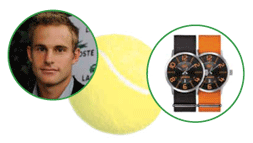 A five year partnership is signed with then 22-year-old tennis champ Andy Roddick in 2005.
A five year partnership is signed with then 22-year-old tennis champ Andy Roddick in 2005.
Lacoste announces its long-term worldwide agreement with Movado Group in 2006. The agreement, effective January 1, 2007, includes the design, production and distribution of men's and women's timepiece collections.
In September 2008, Lacoste, which is celebrating its 75th anniversary, becomes the official sponsor of the Australian Open. As the exclusive supplier of the tournament on and off the courts, the company dresses the linesmen, tournament officials and ball kids. The partnership also includes a retail space on the site.
In 2010, Lacoste partners with Marchon on a license for ophthalmic frames and sunwear.
